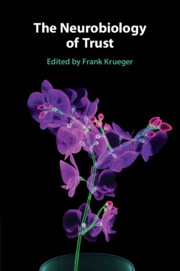Book contents
- The Neurobiology of Trust
- The Neurobiology of Trust
- Copyright page
- Dedication
- Contents
- Figures
- Tables
- Contributors
- Abbreviations
- Introduction
- Part I Fundamental Level of Trust
- Part II Neuropsychological Level of Trust
- Chapter 5 Trust and Risk
- Chapter 6 Trust and Emotion
- Chapter 7 Trust and Reputation
- Chapter 8 Trust and Learning
- Part III Neurocharacteristic Level of Trust
- Part IV Neuromolecular Level of Trust
- Part V Neuropathological Level of Trust
- Index
- References
Chapter 5 - Trust and Risk
Neuroeconomic Foundations of Trust Based on Social Risk
from Part II - Neuropsychological Level of Trust
Published online by Cambridge University Press: 09 December 2021
- The Neurobiology of Trust
- The Neurobiology of Trust
- Copyright page
- Dedication
- Contents
- Figures
- Tables
- Contributors
- Abbreviations
- Introduction
- Part I Fundamental Level of Trust
- Part II Neuropsychological Level of Trust
- Chapter 5 Trust and Risk
- Chapter 6 Trust and Emotion
- Chapter 7 Trust and Reputation
- Chapter 8 Trust and Learning
- Part III Neurocharacteristic Level of Trust
- Part IV Neuromolecular Level of Trust
- Part V Neuropathological Level of Trust
- Index
- References
Summary
Interpersonal trust decisions significantly shape our social interactions with others. At its basis, trust decisions can be thought of as an investment of resources in another that involve a degree of uncertainty as to whether such an investment made in a social exchange may be reciprocated or provide future benefits. In this chapter, interpersonal trust behavior is conceptualized as a microeconomic system and empirical support is presented for how interpersonal trust behavior can be thought of as a decision based on social risk. Decision makers face social risk when another person or group of people is the primary source of uncertainty. Arriving at the decision to trust another often involves psychological processes that occur at the cognitive, emotional, and social levels. Such psychological features are often dependent on the environment and institution surrounding the behavior and may give rise to differential preferences and beliefs such as betrayal aversion. We discuss how functional neuroimaging studies play a central role in disambiguating the contribution of such psychological factors to interpersonal trust behavior. We present key neuroeconomic studies that better our understanding of the neural mechanisms that underlie social risk decisions, and present open questions and future directions for research in this area.
- Type
- Chapter
- Information
- The Neurobiology of Trust , pp. 101 - 123Publisher: Cambridge University PressPrint publication year: 2021



